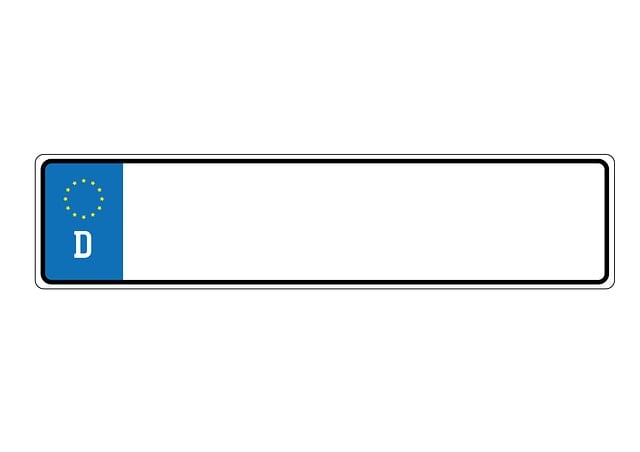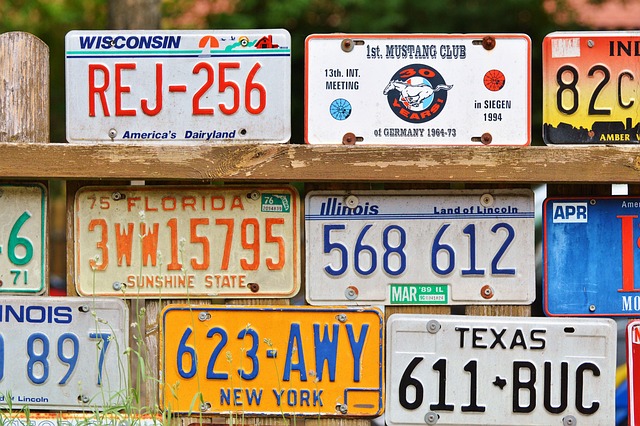In the course of normal use, license plates can sustain damage or become illegible, requiring their replacement. This comprehensive guide details the steps involved in replacing lost or damaged license plates, focusing on both traditional and digital approaches. From understanding when a plate is beyond repair to ensuring compliance with traffic laws after replacement, we’ll walk you through the entire process. Learn how to gather necessary documents, interact with your local DMV, order new plates, and maintain clear identification for your vehicle.
- Understanding When License Plate Replacement is Necessary
- Gather Required Documents and Forms
- Visit Your Local DMV Office or Access Their Online Portal
- Submit the Application and Pay Associated Fees
- Wait for the Issuance of New License Plates
- Ensuring Clear and Legible Plates Post-Replacement
- Compliance with Traffic Laws: The Importance of Updated License Plates
Understanding When License Plate Replacement is Necessary

When a license plate becomes damaged beyond repair or its characters become faded and illegible, it’s time to consider a replacement. While some minor damages might be temporarily fixed with clear coat or protective films, significant wear and tear often require a complete plate swap. Regular maintenance is key; promptly addressing issues like deep scratches, rust spots, or fading can prevent the need for a full replacement.
If you’re faced with a lost or stolen license plate, or simply need to update your existing plates due to extensive use, understanding the DMV’s process for ordering new ones is essential. This typically involves filling out specific forms available at your local DMV office or online, providing proof of vehicle ownership and identity, and paying associated fees. Efficiently navigating this procedure ensures compliance with traffic regulations and avoids potential fines related to outdated or illegible plates.
Gather Required Documents and Forms

To replace a lost or damaged license plate, gather essential documents and forms from your local Department of Motor Vehicles (DMV) office. Typically, this includes proof of vehicle ownership such as a registration document and valid identification like a driver’s license. Some states may also require proof of insurance. It’s important to check with your specific DMV branch for exact requirements, as processes can vary slightly across regions.
Once you have all necessary documents ready, fill out the appropriate forms available at the DMV office or online through their website. These forms usually ask for detailed information about your vehicle and personal details. After completing the paperwork, submit it along with the required fees to initiate the lost license plate replacement process. This ensures that new plates are ordered and your vehicle remains properly identified on the road, adhering to local traffic laws.
Visit Your Local DMV Office or Access Their Online Portal

If your license plate has seen better days, it’s time to visit your local Department of Motor Vehicles (DMV) office or access their online portal for a seamless lost license plate replacement process. The first step is to gather the necessary paperwork, which typically includes proof of vehicle ownership and identification documents. You can find these forms on the DMV’s website under sections dedicated to replace damaged license plates or order new license plates.
The convenience of an online portal allows you to initiate the lost plate DMV process from the comfort of your home, saving time and effort. Alternatively, a physical visit to the office is required for document verification and fee payment. Regardless of your chosen method, ensure you have all required documents and fees ready to streamline the how to replace license plate process. Remember, maintaining clear and legible plates not only ensures proper vehicle identification but also complies with traffic laws, avoiding any potential fines or legal issues related to lost or stolen car plates.
Submit the Application and Pay Associated Fees

Once you’ve gathered all necessary documents and forms, it’s time to submit your application for new license plates. This process is typically straightforward but requires careful attention to detail. At the DMV office, you’ll fill out any required paperwork, ensuring that all information is accurate and up-to-date. This includes providing details about your vehicle, such as its make, model, and year, along with proof of ownership, which might be a registration document or a title certificate. Don’t forget to bring your valid ID to prove your identity.
The next step involves paying the necessary fees for license plate replacement. These costs can vary depending on your location and the type of plates you require. It’s important to inquire about these fees in advance, as some areas might have specific charges for damaged or lost plates. After submitting your application and payment, the DMV will process your request and issue your new, clear license plates, ensuring your vehicle remains legally identified and compliant with local traffic regulations.
Wait for the Issuance of New License Plates

After submitting your application for new license plates, it’s important to be patient as the DMV processes your request. The turnaround time can vary depending on the location and current demand. In many cases, you can expect to receive your new plates within a few business days. However, during peak seasons or in areas with high vehicle traffic, this process might take slightly longer.
During this waiting period, ensure that you are still able to operate your vehicle legally. Some regions may allow you to continue using the old plates until a replacement is issued. Check with your local DMV for their specific guidelines on temporary plate use and any associated fees. Remember, clear license plates are not just a convenience; they are a legal requirement, so staying compliant during this period is crucial.
Ensuring Clear and Legible Plates Post-Replacement

Compliance with Traffic Laws: The Importance of Updated License Plates

Damaged or lost license plates pose a significant challenge for vehicle owners as they can lead to difficulties in adhering to traffic laws and regulations. In many jurisdictions, clear and legible license plates are mandatory for safe and lawful operation on public roads. When a plate becomes unreadable due to wear and tear or an accident, immediate action is required. The process of replacing a lost license plate involves visiting the Department of Motor Vehicles (DMV) office or accessing their online portal to obtain replacement forms. This task is crucial not only for practical reasons but also as a legal obligation.
The importance of updated license plates cannot be overstated when it comes to traffic law compliance. These plates serve as a vital form of identification for vehicles, ensuring that they can be tracked and regulated effectively. Whether it’s for routine police checks or in the event of an accident, clear plate visibility is essential for maintaining order on the roads. By promptly replacing damaged or lost plates, vehicle owners not only facilitate smoother interactions with law enforcement but also contribute to a safer overall driving environment. Additionally, many regions have specific regulations regarding license plate replacement fees, which should be checked and understood before initiating the process.
In conclusion, promptly addressing damaged or illegible license plates is crucial for both vehicle identification and compliance with traffic laws. By following the straightforward steps outlined in this article—from understanding when replacement is necessary to ensuring clear and legible plates post-replacement—drivers can navigate the Lost Plate DMV Process efficiently. Don’t let a lost or stolen car plate lead to unnecessary delays; order new license plates today and stay compliant on the road.



